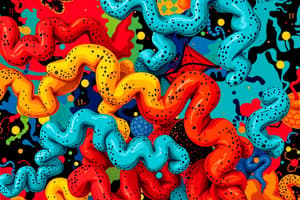Podcast
Questions and Answers
What is the primary function of proteins like hemoglobin?
What is the primary function of proteins like hemoglobin?
- Muscle movement
- Regulation of gene expression
- Storage of nutrients
- Transport of oxygen (correct)
What type of protein is involved in blood clotting?
What type of protein is involved in blood clotting?
- Enzyme
- Globular protein
- Fibrous protein
- Fibrinogen (correct)
What is the characteristic of an amino acid?
What is the characteristic of an amino acid?
- Contains only a carboxyl group
- Contains both an amino group and a carboxyl group (correct)
- Contains only an amino group
- Contains neither an amino group nor a carboxyl group
What is the function of proteins like insulin and oxytocin?
What is the function of proteins like insulin and oxytocin?
What is the function of proteins like collagen and keratin?
What is the function of proteins like collagen and keratin?
What is the function of ferritin?
What is the function of ferritin?
What is the primary role of proteins in cellular processes?
What is the primary role of proteins in cellular processes?
Which of the following proteins is responsible for transporting oxygen from the lungs to cells?
Which of the following proteins is responsible for transporting oxygen from the lungs to cells?
What is the function of proteins in the storage of nutrients?
What is the function of proteins in the storage of nutrients?
What is the characteristic of globular proteins?
What is the characteristic of globular proteins?
What is the function of proteins in the regulation of gene expression?
What is the function of proteins in the regulation of gene expression?
What is the characteristic of an alpha-amino acid?
What is the characteristic of an alpha-amino acid?
Flashcards are hidden until you start studying
Study Notes
Protein Functions
- Proteins provide structure to skin, bone, hair, and nails through collagen and keratin.
- Enzymes, a type of protein, catalyze virtually all reactions in living systems.
- Muscles are composed of proteins called myosin and actin, enabling movement.
- Hemoglobin, a protein, transports oxygen from the lungs to cells, while other proteins transport molecules across cell membranes.
- Many hormones, such as insulin, oxytocin, and human growth hormone, are proteins.
- The protein fibrinogen is involved in blood clotting, and antibodies, another type of protein, fight disease.
- Proteins like casein in milk and ovalbumin in eggs store nutrients for newborn infants and birds.
- Ferritin, a liver protein, stores iron.
- Certain proteins regulate gene expression and control when it takes place.
Protein Types
- There are two main types of proteins: fibrous proteins and globular proteins.
Amino Acids
- An amino acid is a compound containing both an amino group and a carboxyl group.
- In an α-amino acid, the amino group is located on the carbon adjacent to the carboxyl group.
Protein Functions
- Proteins provide structure to skin, bone, hair, and nails through collagen and keratin.
- Enzymes, a type of protein, catalyze virtually all reactions in living systems.
- Muscles are composed of proteins called myosin and actin, enabling movement.
- Hemoglobin, a protein, transports oxygen from the lungs to cells, while other proteins transport molecules across cell membranes.
- Many hormones, such as insulin, oxytocin, and human growth hormone, are proteins.
- The protein fibrinogen is involved in blood clotting, and antibodies, another type of protein, fight disease.
- Proteins like casein in milk and ovalbumin in eggs store nutrients for newborn infants and birds.
- Ferritin, a liver protein, stores iron.
- Certain proteins regulate gene expression and control when it takes place.
Protein Types
- There are two main types of proteins: fibrous proteins and globular proteins.
Amino Acids
- An amino acid is a compound containing both an amino group and a carboxyl group.
- In an α-amino acid, the amino group is located on the carbon adjacent to the carboxyl group.
Studying That Suits You
Use AI to generate personalized quizzes and flashcards to suit your learning preferences.




